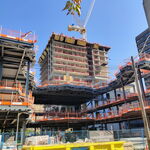reaperexpress
Senior Member
High speed rail would do something you can't measure on any existing modes of travel: induce demand. The ability to get from Kitchener to London in 25 minutes, or from Toronto to Kitchener in 45 minutes would result in a radical change in what is possible in terms of economic connections and commutes. As one example, it would bolster the tech sector in Kitchener as companies would be able to recruit from the much broader pool of talent in Toronto (i.e. not just engineering).
The case for HSR isn't a transportation spending efficiency one, it's an economic development one. Transportation projects aren't just about meeting current needs, and that's been recognized by those who built out our existing transportation networks.
I would argue that the economic development potential of regional rail is greater than for HSR, even for cities which would be served by the latter.
When I say regional rail, I mean limited-stop service connecting the centres of each urban area the corridor (Kitchener, Guelph, Georgetown, Brampton, Pearson, Mount Dennis, Union) at up to 160 km/h on existing tracks and 200 km/h on new tracks. Union-Kitchener would probably take around 1h20. The upgraded tracks would also allow VIA to make the same trip in around 1h10, skipping stops in Georgetown, Mount Dennis and possibly Brampton.
I'll compare it to HSR as per Glen Murray's idea: London - Kitchener - Pearson - Union at up to 320 km/h, probably taking around 0h50. I'm assuming that ticket prices would be roughly the same as current VIA prices (which is rather optimistic). Regional service would probably take around 1h30 to 1h40 from Toronto to Kitchener due to the lower investment in tracks and would not be as frequent as the above scenario. The construction cost would be a fair bit higher, though both scenarios include big expenditures such as a new connection to Pearson Airport and a new freight bypass line from Bramalea to Milton.
The vast majority of trips are not between Kitchener, Pearson and Toronto. We will always have trains serving cities such as Guelph and Brampton, but HSR does absolutely nothing to help these services. Regional rail, on the other hand, would be a single service serving many of the different demand patterns, which makes regular service (at least 1 train per hour) financially viable.
Yes, of course a service with a 50 minute travel time will induce more demand than one with an 70 minute travel time. However, for trips as short as those in the Kitchener-Toronto corridor, service frequency and ticket price are also very significant factors. VIA is already 21 to 29 minutes faster than GO from Kitchener to Toronto, but even with weekend service and an identical number of daily weekday departures, the demand for VIA is minimal while GO is seeing strong and growing ridership. That's because the trip costs $25.99 on VIA but only $14.49 on GO.
The development potential around train stations is greater when the service is more useful day-to-day. Just compare the demand around subway stations to that around GO stations the same distance from downtown Toronto. Living around Kitchener Central station with regional rail would be very attractive because not only would people be able to get to Toronto but they could also get to Guelph, or Brampton. They would be buying into general ease of access, rather than a sort of portal to downtown Toronto.
Yes, I realize that there is a small group of higher-income workers who would shell out big bucks to save 20 minutes on the trip, but I don't think that that benefit outweighs the increased intensification incentive in downtown Kitchener. It certainly doesn't pay off when the relative benefits to downtown Guelph and downtown Brampton are considered.
West of Kitchener, HSR makes more sense. The larger distances between cities means that the massive expenditure in HSR actually results in big time savings, and there is little need for other services.
Last edited:






